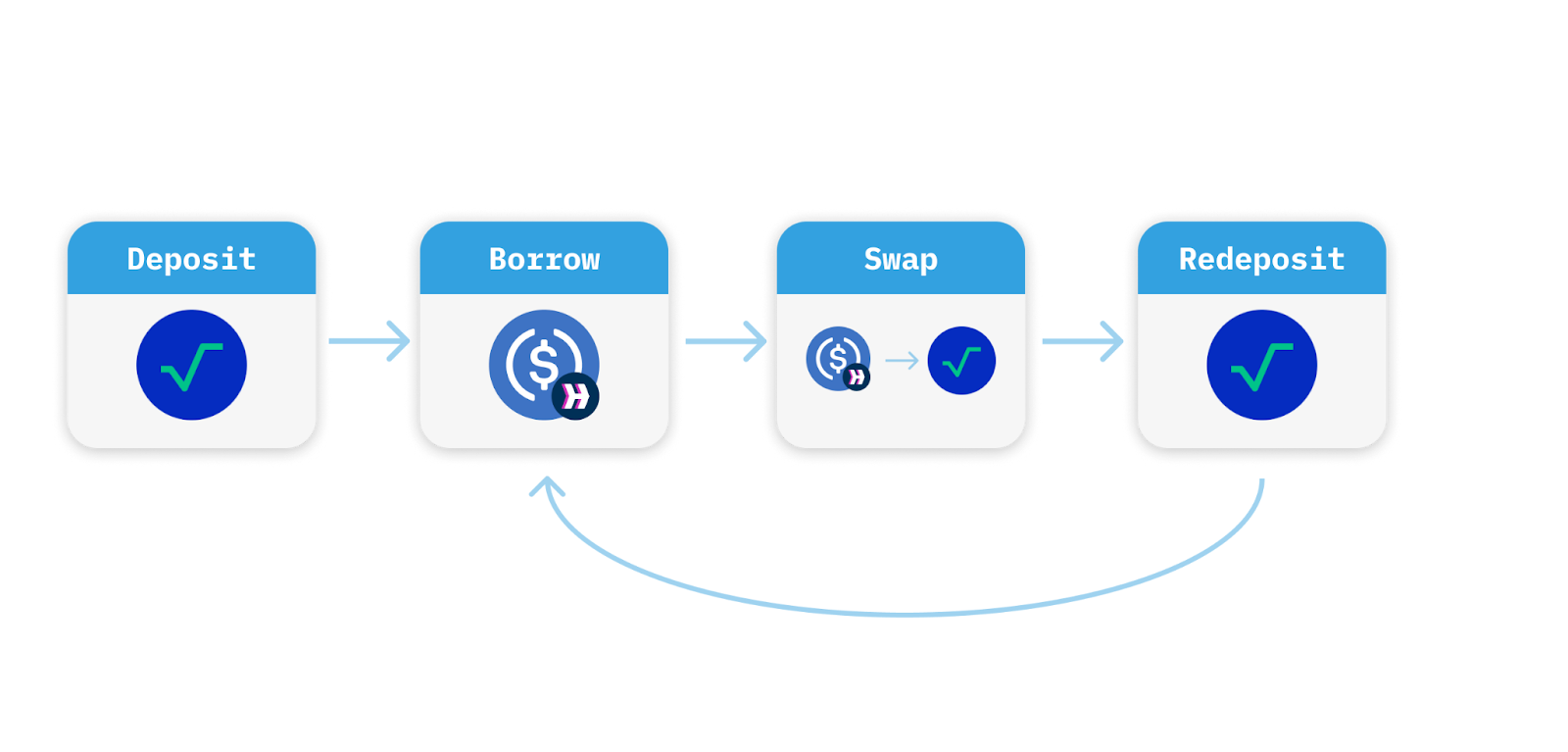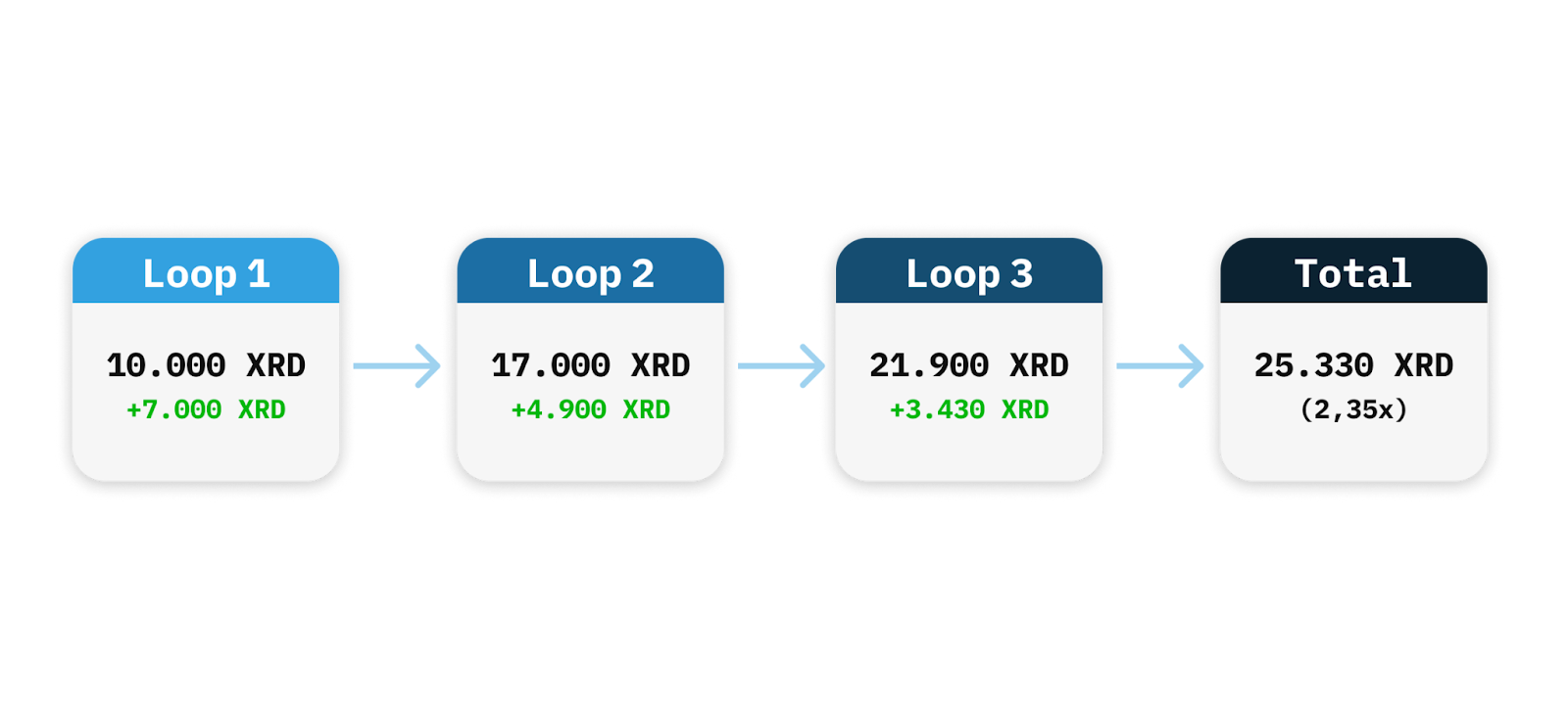This content is for educational purposes only and does not constitute financial advice. Always do your own research before implementing any DeFi strategies and understand the risks involved.
DeFi looping has become one of the most popular strategies for earning enhanced yields and gaining leveraged exposure to assets. As the Radix ecosystem continues to grow with robust lending platforms and DEXs, understanding how to loop effectively can help you maximize your DeFi opportunities. This tutorial will walk you through what looping is, how it works on Radix, and the risks you need to consider.
What is DeFi Looping?
Looping is a strategy where you deposit collateral into a lending platform, borrow against it, swap the borrowed assets for more of your original collateral, and repeat the process multiple times. Think of it as creating a leverage position through recursive borrowing and lending.
The strategy essentially allows you to:
- Gain leveraged exposure to an asset without using derivatives
- Earn lending rewards on a larger collateral position
- Potentially earn borrowing rewards if the platform offers incentives (e.g., Root Points on Root Finance)
- Increase your capital efficiency in DeFi protocols

How Does Looping Work on Radix?
On Radix, you can implement looping strategies using lending platforms like Root or WEFT. Here's the basic flow:
- Deposit collateral (e.g., XRD) into Root or WEFT
- Borrow stablecoins (e.g., hUSDT) against your collateral
- Swap the borrowed stablecoins for more XRD on Ociswap, CaviarNine, or Astrolescent
- Deposit the new XRD back as collateral
- Repeat the process until you reach your desired leverage
Each loop increases your exposure to XRD price movements while potentially increasing your yield from lending rewards.
Key Risks to Understand
1. Liquidation Risk
The biggest risk in looping is liquidation. When your health factor drops below 1.0, the lending protocol automatically liquidates your position to protect lenders.
When Liquidation is Triggered:
- A liquidator (bot or user) repays part or all of your debt
- They receive your collateral at a discount
- The protocol may charge additional fees (see protocol documentation)
- Your position is forcibly closed automatically, you have no choice in this
Why Liquidation is a Risk:
- You sell during a price drop: Liquidation happens during price drops, locking in your losses
- You don't get full value: Liquidators take your collateral at a discount (their profit is your loss)
- Double penalty: You pay both the liquidation bonus to liquidators AND a penalty fee to the protocol
- No recovery option: Once liquidated, your position is closed
- Cascade effect: Partial liquidations can trigger full liquidations as your leverage increases
2. Interest Rate Risk
You're paying borrow interest on hUSDT while earning supply interest on XRD. If the borrow rate exceeds your earnings, you'll have negative carry.
What is negative carry?
Simply put, negative carry means you are losing money by holding the position. If you are paying 8% to borrow but are only earning 5% on your collateral, you are losing 3% annually - even if the price does not move.
3. Price Risk
Leverage amplifies both gains and losses. With our 2.53x leveraged position:
- If XRD rises 10%, you gain ~25%
- If XRD falls 10%, you lose ~25%
However, on the downside, liquidation may cut your losses before they reach the full leveraged percentage. In our example, a 13-14% price drop would trigger liquidation, meaning you'd lose most of your initial collateral before experiencing the full theoretical loss. However, the cost of liquidation explained above could be even greater.
Step-by-Step Example: XRD/hUSDT Loop on Root
Let's walk through a practical example using XRD and hUSDT on Root, assuming:
- You start with 10,000 XRD
- Root's XRD collateral factor is 70% (you can borrow up to 70% of your collateral value)
- Exchange rate: 1 hUSDT = 20 XRD (example rate)
Loop 1: Initial Position
- Deposit 10,000 XRD as collateral
- Your collateral value in hUSDT terms: 500 hUSDT equivalent
- Borrow 350 hUSDT (70% of 500)
- Swap 350 hUSDT for 7,000 XRD on a DEX
- Deposit the 7,000 XRD back into Root
- New total collateral: 17,000 XRD
Loop 2: Building Leverage
- Your collateral: 17,000 XRD (850 hUSDT equivalent value)
- Total borrowing capacity: 595 hUSDT (70% of 850)
- Already borrowed: 350 hUSDT
- Borrow an additional 245 hUSDT (595 - 350)
- Swap 245 hUSDT for 4,900 XRD
- Deposit back into Root
- New total collateral: 21,900 XRD
Loop 3: Approaching Target
- Your collateral: 21,900 XRD (1,095 hUSDT equivalent value)
- Total borrowing capacity: 766.5 hUSDT (70% of 1,095)
- Already borrowed: 595 hUSDT
- Borrow an additional 171.5 hUSDT (766.5 - 595)
- Swap 171.5 hUSDT for 3,430 XRD
- Deposit back into Root
- New total collateral: 25,330 XRD

After three loops, you've turned your 10,000 XRD position into 25,330 XRD of exposure (2.53x leverage), while borrowing 766.5 hUSDT total.
Important Note: At 2.53x leverage with a 70% collateral factor, your health factor is approximately 1.15. This means you have limited buffer before liquidation - a price drop could trigger liquidation. If liquidated, the protocol automatically sells your collateral to repay the debt, and you lose most of your initial investment. This illustrates why conservative leverage targets are crucial.
Calculating Your Maximum Leverage
The maximum theoretical leverage you can achieve through looping depends on the collateral factor (loan-to-value ratio):
Maximum Leverage = 1 / (1 - Collateral Factor)
For example:
- 70% collateral factor = 1 / (1 - 0.70) = 1 / 0.30 = 3.33x maximum theoretical leverage
- 80% collateral factor = 1 / (1 - 0.80) = 1 / 0.20 = 5x maximum theoretical leverage
Important: Never loop to the theoretical maximum! This would leave you with zero buffer and instant liquidation risk. Always maintain a safety margin. For a 70% collateral factor, target 2-2.5x leverage maximum.
The Economics of Looping
When you loop, you're essentially:
- Earning: Supply APY on your total collateral position
- Paying: Borrow APY on your total debt
- Exposed to: Amplified price movements of your collateral asset
Your net APY = [(Supply APY × Total Collateral Value) - (Borrow APY × Total Debt Value)] / Initial Capital
For example, with our 2.53x leveraged position:
- If XRD supply APY is 5% and hUSDT borrow APY is 8%
- You earn: 5% on 25,330 XRD of collateral
- You pay: 8% on 766.5 hUSDT of debt
- Your net return depends on the rate differential and XRD price movement
This means looping is most profitable when:
- Supply rates exceed borrow rates (positive carry)
- You're bullish on the collateral asset
- The rate differential outweighs the borrowing costs
Risk Management Best Practices
Set Conservative Targets. Don't loop to maximum leverage. With a 70% collateral factor:
- Maximum theoretical: 3.33x (extremely dangerous with a high risk of liquidation)
- Our example: 2.53x (still risky with 13-14% liquidation threshold)
- Safer: 2.0-2.2x (provides 20-25% price buffer)
Target 50-70% of the theoretical maximum for better safety.
Monitor Health Factor: Keep your loan health factor above 1.5 on Root or WEFT. This gives you a buffer during market volatility.
Calculate Your Liquidation Price: Before looping, know exactly at what price ratio you'll be liquidated. The formula:
- Health Factor = (Collateral Value × Collateral Factor) / Borrowed Value
- You're liquidated when Health Factor < 1.0
For our 2.53x leverage example:
- Health Factor starts at ~1.15
- This means only a ~13-14% price drop could trigger liquidation
- At maximum leverage (3.33x), even smaller price movements become dangerous
Always calculate based on your exact collateral, debt, and liquidation thresholds. The higher your leverage, the smaller the price movement needed to liquidate you.
Have an Exit Strategy: Know how to unwind your position:
- Withdraw some collateral
- Swap to hUSDT
- Repay part of your loan
- Repeat until fully unwound
Start Small: Test with a small position first to understand the mechanics and associated costs.
Alternative Looping Strategies
Stablecoin Looping
Instead of looping volatile assets, you can loop stablecoins for lower risk:
- Deposit xUSDC as collateral
- Borrow hUSDT
- Swap hUSDT for xUSDC
- Redeposit and repeat
This strategy has minimal liquidation risk but lower potential returns.
Cross-Asset Looping
Loop between different assets for diversification:
- Deposit xETH as collateral
- Borrow hUSDT
- Swap for xWBTC
- Deposit xWBTC as additional collateral
This creates exposure to multiple assets while maintaining the loop structure.
Tools and Platforms for Looping on Radix
Lending Platforms
- Root: Supports XRD, hAssets, LSULP, some ecosystem tokens, and offers a rewards program
- WEFT: Supports XRD, hAssets, and LSULP
DEXs for Swapping
Monitoring Tools
- Track your health factor directly on Root or WEFT
- Use portfolio trackers to watch your total exposure
- Set up alerts for significant price movements
- Monitor on-chain activity and your wallets using Notix
Getting Started with Your First Loop
- Calculate Your Risk: Determine your target leverage and liquidation price
- Start Small: Begin with 1.5-2x leverage to learn the mechanics
- Choose Your Platform: Compare rates between Root and WEFT
- Monitor Actively: Check your position daily, especially during volatile markets
Advanced Considerations
Optimal Loop Size
Most of the additional exposure is achieved in the first 3-5 loops. As you add more loops, each successive loop adds less leverage due to diminishing returns:
- Loop 1: Adds 7,000 XRD (70% increase from initial)
- Loop 2: Adds 4,900 XRD (28.8% increase from Loop 1 total)
- Loop 3: Adds 3,430 XRD (15.7% increase from Loop 2 total)
- Loop 4: Would add ~2,400 XRD (~9.5% increase)
- Loop 5: Would add ~1,700 XRD (~6.3% increase)
Beyond ~10 loops, the gains become negligible compared to effort. This is why automated looping protocols (not yet available on Radix) use flash loans to achieve target leverage in a single transaction.
Timing Your Entry
Consider market conditions:
- High volatility = higher liquidation risk
- Rising rates = increasing borrow costs
- Platform incentives = additional yield opportunities
Common Mistakes to Avoid
Over-leveraging: The temptation to maximize leverage often leads to liquidation
Ignoring Rates: Not monitoring changing borrow/supply rates can turn profitable positions negative
Forgetting About Fees: DEX swap fees and potential withdrawal fees can eat into profits
Panic Unwinding: Trying to close positions too quickly during volatility can lead to unnecessary losses
Not Testing First: Always test with small amounts to understand the full process
Conclusion
Looping can be a powerful tool for experienced DeFi users looking to maximize their capital efficiency on Radix. However, it requires careful planning, constant monitoring, and strict risk management. The key to successful looping is finding the right balance between leverage and safety.
Start conservatively, understand the mechanics thoroughly, and always keep liquidation risk at the forefront of your strategy. Remember that while looping can amplify your gains, it equally amplifies your losses.
Ready to try looping? Start by checking the current lending rates on Root or WEFT and plan your strategy accordingly. As always, only risk what you can afford to lose and monitor your positions actively.



.svg)



